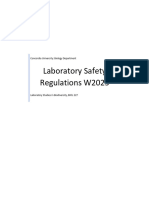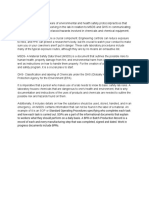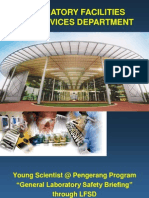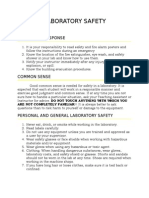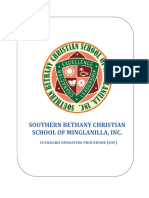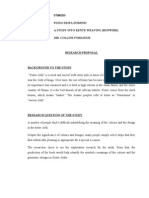General Laboratory Rules
General Laboratory Rules
Uploaded by
Carmel Anne Trawon TumaponCopyright:
Available Formats
General Laboratory Rules
General Laboratory Rules
Uploaded by
Carmel Anne Trawon TumaponOriginal Title
Copyright
Available Formats
Share this document
Did you find this document useful?
Is this content inappropriate?
Copyright:
Available Formats
General Laboratory Rules
General Laboratory Rules
Uploaded by
Carmel Anne Trawon TumaponCopyright:
Available Formats
General Laboratory Rules
• Know locations of laboratory safety showers, eyewash stations, and fire extinguishers. The
safety equipment may be located in the hallway near the laboratory entrance.
• Know emergency exit routes.
• Avoid skin and eye contact with all chemicals.
• Minimize all chemical exposures.
• No horseplay will be tolerated.
• Assume that all chemicals of unknown toxicity are highly toxic.
• Post warning signs when unusual hazards, hazardous materials, hazardous equipment, or other
special conditions are present.
• Avoid distracting or startling persons working in the laboratory.
• Use equipment only for its designated purpose.
• Combine reagents in their appropriate order, such as adding acid to water.
• Avoid adding solids to hot liquids.
• All laboratory personnel should place emphasis on safety and chemical hygiene at all times.
• Never leave containers of chemicals open.
• All containers must have appropriate labels. Unlabeled chemicals should never be used.
• Do not taste or intentionally sniff chemicals.
• Never consume and/or store food or beverages or apply cosmetics in areas where hazardous
chemicals are used or stored.
• Do not use mouth suction for pipetting or starting a siphon.
• Wash exposed areas of the skin prior to leaving the laboratory.
• Long hair and loose clothing must be pulled back and secured from entanglement or potential
capture.
• No contact lenses should be worn around hazardous chemicals – even when wearing safety
glasses.
• Laboratory safety glasses or goggles should be worn in any area where chemicals are used or
stored. They should also be worn any time there is a chance of splashes or particulates to enter
the eye. Closed toe shoes will be worn at all times in the laboratory. Perforated shoes or sandals
are not appropriate.
• Determine the potential hazards and appropriate safety precautions before beginning any work.
• Procedures should be developed that minimize the formation and dispersion of aerosols.
• If an unknown chemical is produced in the laboratory, the material should be considered
hazardous.
• Do not pour chemicals down drains. Do NOT utilize the sewer for chemical waste disposal.
• Keep all sink traps (including cup sink traps and floor drains) filled with water by running water
down the drain at least monthly.
• Do not utilize fume hoods for evaporations and disposal of volatile solvents.
• Perform work with hazardous chemicals in a properly working fume hood to reduce potential
exposures.
• Avoid working alone in a building. Do not work alone in a laboratory if the procedures being
conducted are hazardous.
• The PEL and the Threshold Limit Values (TLV) will be observed in all areas. If exposure above
a PEL/TLV is suspected for an ongoing process, please contact EHS immediately.
• Laboratory employees should have access to a chemical inventory list, applicable SDSs,
Department Laboratory Safety Manual, and relevant SOPs.
• Access to laboratories and support areas such as stockrooms, specialized laboratories, etc.
should be limited to approved personnel only.
• All equipment should be regularly inspected for wear or deterioration.
• Equipment should be maintained according to the manufacturer’s requirements and records of
certification, maintenance, or repairs should be maintained for the life of the equipment.
• Designated and well-marked waste storage locations are necessary.
• No cell phone or ear phone usage in the active portion of the laboratories, or during experimental
operations.
• Clothing made of synthetic fibers should not be worn while working with flammable liquids or
when a fire hazard is present as these materials tend to melt and stick to exposed skin.
• Laboratory coats should not be stored in offices or break rooms as these spreads contaminates
to other areas.
• Computers and instrumentation should be labeled to indicate whether gloves should be worn or
not. Inconsistent glove use around keyboards/keypads is a source of potential contamination.
• Avoid wearing jewelry in the lab as this can pose multiple safety hazards.
You might also like
- Wislawa Szymborska 2012 7Document45 pagesWislawa Szymborska 2012 7MayaAmano100% (1)
- Safety Policies in A Chemical LaboratoryDocument2 pagesSafety Policies in A Chemical Laboratorynieldurante1519No ratings yet
- Safety in The LaboratoryDocument15 pagesSafety in The Laboratoryمحمد آل راشدNo ratings yet
- Important Laboratory Safety GuidelinesDocument5 pagesImportant Laboratory Safety GuidelinesJaiNo ratings yet
- Biochem Act 1Document8 pagesBiochem Act 1sanji vinsmokeNo ratings yet
- Setup Animal HouseDocument13 pagesSetup Animal HouseEr Purushottam PalNo ratings yet
- Good Laboratory PracticeDocument10 pagesGood Laboratory PracticePrince MoniNo ratings yet
- Lab Safety Dos DontsDocument3 pagesLab Safety Dos DontsMurali KrishnaNo ratings yet
- Laboratory SaftyDocument2 pagesLaboratory Saftyseidh006No ratings yet
- Practical 1Document31 pagesPractical 1iramashfaq741No ratings yet
- Laboratory Safety and Guidelines-1Document6 pagesLaboratory Safety and Guidelines-1azra12740No ratings yet
- Lab Safety PDFDocument2 pagesLab Safety PDFnandusp1No ratings yet
- General Laboratory Safety RulesDocument9 pagesGeneral Laboratory Safety RulesJane Anda100% (1)
- Mayor, Royal and Pontifical University of San Francisco Xavier of ChuquisacaDocument4 pagesMayor, Royal and Pontifical University of San Francisco Xavier of ChuquisacaJuan José Tirado BalcasNo ratings yet
- BABS2213 Principles of Genetics - Lab ManualDocument61 pagesBABS2213 Principles of Genetics - Lab Manual门门No ratings yet
- Cookery, BPP and Food & Beverage Lab Manual: General Laboratory Safety RulesDocument7 pagesCookery, BPP and Food & Beverage Lab Manual: General Laboratory Safety RulesMay nuqueNo ratings yet
- Lab Safety Rules and GuidelinesDocument11 pagesLab Safety Rules and GuidelinesFaiza SaleemNo ratings yet
- Laboratory Safety Regulations W2023 BIOL227Document8 pagesLaboratory Safety Regulations W2023 BIOL227gaelle abi ghanemNo ratings yet
- Laboratory ToolsDocument24 pagesLaboratory ToolsJohn Murphy AlmarioNo ratings yet
- Lab Safety Rules and GuidelinesDocument11 pagesLab Safety Rules and Guidelinesbassam alharaziNo ratings yet
- Laboratory SafetyDocument8 pagesLaboratory SafetyChris GayleNo ratings yet
- Here Are The Safety Rules That Most Commonly Came Up in Our Look at Several LaboratoriesDocument4 pagesHere Are The Safety Rules That Most Commonly Came Up in Our Look at Several LaboratoriesLovely RingorNo ratings yet
- Chemical Handling Safety Guidelines - LectureDocument24 pagesChemical Handling Safety Guidelines - LecturemichelleNo ratings yet
- General SAS Laboratory Safety Awareness For Student AY2021Document48 pagesGeneral SAS Laboratory Safety Awareness For Student AY2021Lim Liang XuanNo ratings yet
- Lecture 4Document36 pagesLecture 4kelvinNo ratings yet
- 4 Sop General Lab 2013-07Document25 pages4 Sop General Lab 2013-07EmaNo ratings yet
- 4 Sop General Lab 2016-01Document30 pages4 Sop General Lab 2016-01TiwiNo ratings yet
- PurposeDocument10 pagesPurposeKIANNA FLORESNo ratings yet
- New Safety Undergraduate TrainingDocument61 pagesNew Safety Undergraduate Trainingsybae0812No ratings yet
- Safety Briefing On Young Scientist at Pengerang LaboratoryDocument30 pagesSafety Briefing On Young Scientist at Pengerang Laboratorykingleoric90No ratings yet
- Introduction To Multidisplinary LaboratoryDocument18 pagesIntroduction To Multidisplinary LaboratoryMohd ShahrulfahmiNo ratings yet
- Safetymanual ChemistryDocument13 pagesSafetymanual ChemistryChandrasreeNo ratings yet
- Risk Management Laboratory Standard Operating ProceduresDocument10 pagesRisk Management Laboratory Standard Operating ProceduresaKureishi100% (1)
- Lab SafetyDocument4 pagesLab SafetyirfanjdNo ratings yet
- The Laboratory SafetyDocument6 pagesThe Laboratory SafetyKevin KipropNo ratings yet
- Lab SopDocument11 pagesLab SopEdralyn Panes VillacrucisNo ratings yet
- Laboratory Safety PracticesDocument20 pagesLaboratory Safety Practicesmoha19841No ratings yet
- Boratory Sfety PracticesDocument20 pagesBoratory Sfety PracticesBabbooNo ratings yet
- Laboratory Safety 29 CFR 1910.1450Document37 pagesLaboratory Safety 29 CFR 1910.1450Babboo100% (1)
- Laboratory Safety GuidelinesDocument26 pagesLaboratory Safety GuidelinesShanu ShanmukhNo ratings yet
- Safety in The Chemistry LaboratoryDocument5 pagesSafety in The Chemistry LaboratoryElma Kit Aquino GolocanNo ratings yet
- Chem Safety TrainingDocument28 pagesChem Safety TrainingamarredifNo ratings yet
- Appendix-BDocument5 pagesAppendix-Bmudassir qazalbashNo ratings yet
- Safety Precautions Inside The LaboratoryDocument5 pagesSafety Precautions Inside The LaboratoryDr. Navya Pakalapati100% (1)
- Hazardous Chemicals & Safe Chemical HandlingDocument40 pagesHazardous Chemicals & Safe Chemical HandlingSaqib JahNo ratings yet
- Safety Orientation On Chemistry LaboratoryDocument27 pagesSafety Orientation On Chemistry LaboratoryMarynnAngel HinulosBeñasNo ratings yet
- Laboratory Safety and Waste DisposalDocument21 pagesLaboratory Safety and Waste DisposalNank TrisnaNo ratings yet
- CH 107, Intro To Chemistry Lab Portland State University Eric Sheagley, Lab Supervisor Fall, 2017Document5 pagesCH 107, Intro To Chemistry Lab Portland State University Eric Sheagley, Lab Supervisor Fall, 2017HieuNo ratings yet
- General Laboratory Safety: Summary of The Main FactorsDocument24 pagesGeneral Laboratory Safety: Summary of The Main FactorsJanielle Medina FajardoNo ratings yet
- Final 1Document22 pagesFinal 1clyde clarionNo ratings yet
- Lab Safety Contract PDFDocument2 pagesLab Safety Contract PDFjadeNo ratings yet
- CHEM 503 Lab Manual-2024Document85 pagesCHEM 503 Lab Manual-2024Hussain RazaNo ratings yet
- OSHA LabSafetyDocument37 pagesOSHA LabSafetymoha19841No ratings yet
- General Lab Safety ProcedureDocument16 pagesGeneral Lab Safety ProcedureMin ingNo ratings yet
- Lab Safety 1Document77 pagesLab Safety 1biomedlabsciNo ratings yet
- Lab Safety-1 1Document18 pagesLab Safety-1 1api-95181781No ratings yet
- Laboratory & Chemical Safety GuideDocument23 pagesLaboratory & Chemical Safety GuideOwinkAgung Prabowo RasminDaudNo ratings yet
- Laboratory - Manual For Principles of BiologyDocument45 pagesLaboratory - Manual For Principles of BiologyGUWANI PRABODHANo ratings yet
- Laboratory Techniques and MethodsDocument82 pagesLaboratory Techniques and MethodsBennieNo ratings yet
- Organic Chem.Document6 pagesOrganic Chem.felescosorheaNo ratings yet
- Athletics Throwing EventsDocument8 pagesAthletics Throwing EventsJehan PugosaNo ratings yet
- Sleigh Ride Sweater in Paintbox Yarns NDownloadable PDF - 2Document6 pagesSleigh Ride Sweater in Paintbox Yarns NDownloadable PDF - 2María PilarNo ratings yet
- A Christmas DreamDocument3 pagesA Christmas DreamMariana Gabriela TrandafirNo ratings yet
- Acetic AnhydrideDocument6 pagesAcetic AnhydrideYojana SonawaneNo ratings yet
- Samsung Front Load WasherDocument56 pagesSamsung Front Load Washerbear65No ratings yet
- Joke CompilationDocument128 pagesJoke CompilationkashifnooraniNo ratings yet
- ProposalDocument3 pagesProposalKlinsmann MatthewNo ratings yet
- Feuille D'albumDocument5 pagesFeuille D'albumMohammad JavadNo ratings yet
- WMT01Document24 pagesWMT01srxwdsn6msNo ratings yet
- Story - The SkierDocument4 pagesStory - The Skiersammar0212No ratings yet
- New Microsoft Word DocumentDocument6 pagesNew Microsoft Word DocumentAnonymous nTxB1EPvNo ratings yet
- Bezel Rivoli TutorialDocument2 pagesBezel Rivoli TutorialMaria Vescan100% (4)
- Firecatalog 4432 20181221 v1Document32 pagesFirecatalog 4432 20181221 v1Anonymous C4PJCOz6No ratings yet
- Grooming & EtiquetteDocument35 pagesGrooming & EtiquetteDum Dida DidaNo ratings yet
- English Download A2 Unit 2 Test: The Past in Another CountryDocument2 pagesEnglish Download A2 Unit 2 Test: The Past in Another CountryTadeo GarcíaNo ratings yet
- Chamomile Flower Extract MSDS: Section 1: Chemical Product and Company IdentificationDocument5 pagesChamomile Flower Extract MSDS: Section 1: Chemical Product and Company IdentificationAgung PriyantoNo ratings yet
- American Dream Essay ThesisDocument10 pagesAmerican Dream Essay Thesisafibjdvvghebod100% (2)
- BSPGSP Programme 2023Document4 pagesBSPGSP Programme 2023Jofel Christian Meneses100% (2)
- The Complete Capes and CowlsDocument42 pagesThe Complete Capes and CowlsRichardWatkins100% (4)
- Guide To Classic Menswear BrandsDocument159 pagesGuide To Classic Menswear BrandsAtem1100% (1)
- براجرافات انجليزى الصف الثانى الإعدادى الترم الثانى 2022Document17 pagesبراجرافات انجليزى الصف الثانى الإعدادى الترم الثانى 2022cafubodoNo ratings yet
- Devoir de Contrôle N°2 - Anglais - 7ème (2012-2013) Mme Feiza Ketteni PDFDocument5 pagesDevoir de Contrôle N°2 - Anglais - 7ème (2012-2013) Mme Feiza Ketteni PDFmethnani chaimaNo ratings yet
- Credit, Consumption and Images of Women's DesiresDocument36 pagesCredit, Consumption and Images of Women's DesiresGabriela MitidieriNo ratings yet
- Around The World in 80 DaysDocument171 pagesAround The World in 80 DaysAJAY SANSARWALNo ratings yet
- Cabin BaggageDocument3 pagesCabin BaggageyikmingleeNo ratings yet
- Bra Size - WikipediaDocument10 pagesBra Size - WikipediaInfo Cal-TekNo ratings yet
- Ayurveda in Daily LifeDocument4 pagesAyurveda in Daily LifeshivaNo ratings yet
- Vocabulary Unit 1 Lesson 1 + 2Document9 pagesVocabulary Unit 1 Lesson 1 + 2nguyenchauvucrkhanhhoa100% (1)
- Jharkhand CraftDocument12 pagesJharkhand CraftnikhilsultaniaNo ratings yet

















